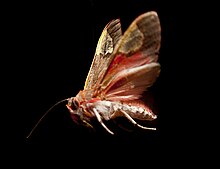| Grote's bertholdia | |
|---|---|

| |
| Scientific classification | |
| Domain: | Eukaryota |
| Kingdom: | Animalia |
| Phylum: | Arthropoda |
| Class: | Insecta |
| Order: | Lepidoptera |
| Superfamily: | Noctuoidea |
| Family: | Erebidae |
| Subfamily: | Arctiinae |
| Genus: | Bertholdia |
| Species: | B. trigona |
| Binomial name | |
| Bertholdia trigona (Grote, 1879) | |
| Synonyms | |
| |
Bertholdia trigona, or Grote's bertholdia, is a species of moth in the family Erebidae. The species was first described by Augustus Radcliffe Grote in 1879. It is prevalent in the southwestern United States.
In studies performed at Wake Forest University, these moths were shown to have developed the ability to disrupt the echolocation of bats. This insect is one of several moths known to jam its predator's echolocation and has the highest recorded click rate of any moth species, a feature hypothesized to increase the effectiveness of jamming.
References
- ^ Savela, Markku. "Bertholdia trigona (Grote, 1879)". Lepidoptera and Some Other Life Forms. Retrieved September 10, 2019.
- Joyce, Christopher (July 17, 2009). "Moths Outwit Bats By Jamming Sonar". Morning Edition. National Public Radio.
- Corcoran, Aaron J.; Conner, William E. (2012-12-15). "Sonar jamming in the field: effectiveness and behavior of a unique prey defense". Journal of Experimental Biology. 215 (24): 4278–4287. doi:10.1242/jeb.076943. ISSN 0022-0949.
- Corcoran, Aaron (2015). "Negligible energetic cost of sonar jamming in a bat–moth interaction". Canadian Journal of Zoology. 93: 331–335 – via ResearchGate.
External links
- Lotts, Kelly & Naberhaus, Thomas (2017). "Bertholdia trigona (Grote, 1879)". Butterflies and Moths of North America. Retrieved September 10, 2019.
- Corcoran, Aaron. SonarJamming.com. Sensory and Movement Ecology Lab at UC Colorado Springs.
| Taxon identifiers | |
|---|---|
| Bertholdia trigona |
|